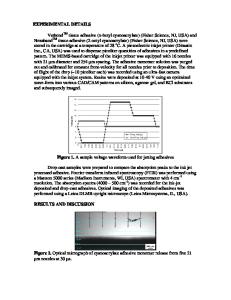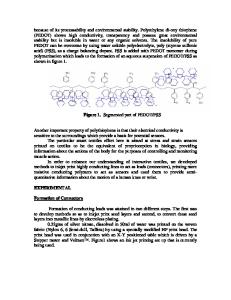Deposition of PEDOT/SWCNT Composites by Inkjet Printing
- PDF / 285,505 Bytes
- 9 Pages / 612 x 792 pts (letter) Page_size
- 89 Downloads / 322 Views
1260-T07-02
Deposition of PEDOT/SWCNT Composites by Inkjet Printing Peter D. Angelo & Ramin R. Farnood Department of Chemical Engineering & Applied Chemistry, University of Toronto Pulp & Paper Centre 200 College Street, Toronto, M5G3A1, Canada. ABSTRACT Poly(3,4-ethylenedioxythiophene):poly(styrenesulfonate), or PEDOT:PSS, a conductive polymer suspension, as well as carbon nanotubes (CNTs), were incorporated into a conductive ink suitable for use in a piezoelectric inkjet printer. Viscosity, surface tension, and particle size of the ink were controlled to achieve stable, high-resolution printing. Passage of the CNTs through the filtration and jetting steps involved in printing was evaluated using scanning transmission electron microscopy (STEM), UV-visible spectroscopy, and zeta-potential measurements of the filtered and printed inks. Only single-walled nanotubes (SWCNTs) passed through the jetting stage in significant amounts. Printed PEDOT/SWCNT sheet resistance was effectively minimized at ~1 kΩ/on cellulose acetate, in ink containing 6 w/w% of an aqueous SWCNT solution (approximately 0.04 w/w% SWCNTs).
INTRODUCTION Recently, inkjet-printed electronics have attracted attention as a promising alternative to conventionally prepared electronic devices. Inkjet printing is a versatile technique affording several advantages over methods such as photolithography and vapour deposition, such as single-step processing, comparable resolution, and low firing and curing temperatures [1-6]. Because inkjet printers require nanoscale particle sizes in the ink pigments [2, 4, 7, 10], printable electronics require inks containing either suspended nanoparticles or emulsified polymers. Furthermore, the liquid ink must have certain rheological properties in order to correctly form droplets from the printer nozzles [1, 2, 4, 8-10]. The Fujifilm-Dimatix Materials Printer (DMP2831) has become a common tool for qualifying the printability of both conventional and specialty inks. In this study, the DMP2831 was used to study the feasibility of directly depositing wet precursors to electrically conductive layers. The translucent conductive polymer, poly(ethylenedioxythiophene) or PEDOT, dispersed in solution using poly(styrenesulfonate) ion (PSS-), was used as a subject material. Carbon nanotubes (CNTs), both single-walled (SW) and multi-walled (MW), which are promising solution-processed electrode materials, were added to the PEDOT layer to improve conductivity. Another consideration in the development of inkjet-printed electronics is the substrate which supports such devices. Typical electronics are deposited on rigid, smooth materials such as glass, silicon, or metal [11]. However, the use of inkjet printing necessitates liquid precursor materials, which in turn facilitates the use of low-temperature curing to produce solid films. Therefore, alternative substrates such as polymers or paper – offering advantages in flexibility and roll-to-roll processability – have been considered [12, 13].
EXPERIMENTS PEDOT:PSS/CNT inkjet inks were
Data Loading...











